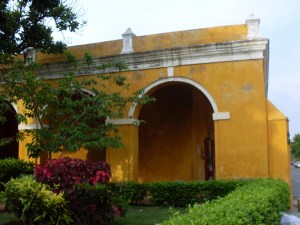
Piezas de ébano: Once arrived in the port the slave ship, the slaves were crowded into places usually wet, narrow and smelly, the first purpose fatten a bit to get a good price for them on the market. [Engraving of the Seventeenth Century: an everyday scene, sale of slaves in the port of Cartagena de Indias. (Collection of the Archivo General de Colombia.)]

Cartagena de Indias, principal place of slavery in New Granada (Columbia)
At the beginning of the seventeenth century Cartagena was the most important stronghold of the defensive system of the Spanish Caribbean, one of two authorized ports in the Spanish possessions in America to introduce negro slaves and parking spot of the galleon fleet in its trade with South and Central America. The combination of these three characteristics he gave to the city an air of dynamism and progress that had not before or later, became the center of economic, political and military Colombian Caribbean and gave it an importance to the Crown not reached the limits of the Caribbean.
Route of entry into vast territories leading to the Andean centers of production of gold and silver, with a bay that was one of the largest placid and safe in all America, was key in the system of communication and exchange between Spain and its American colonies, as in his defensive system.

The monopoly of foreign trade and the slave trade radically transformed the social life of Cartagena, giving it a distinctive identity in the trade of New Granada. The decisive element in this transformation was the massive importation of tens of thousands of blacks, most of them residents of the city to be output to lands of Peru, Quito, Panama and the interior of New Granada. The facilities of its import and its subsequent acquisition by the elite Cartagena changed the composition of the population. The Indian parcel lost importance with the dramatic reduction of the natives, who were replaced by a growing number of blacks in larger work of the farms and urban occupations.

Former slave market in Cartagena, Columbia
Unlike other major cities of New Granada, including the Colombian Caribbean coast, Cartagena de Indias acquired since the seventeenth century the distinction of being a city predominantly black and mulatto. But not only was this change. The city was filled with foreigners especially Portuguese and Dutch business linked to slavery, to the point that the Crown decided to establish there the Tribunal of the Inquisition to the Caribbean and northern South America, with the main objective of curbing the activities of Jews, Protestants and heretics of different nationalities, the port attracted by the possibilities of doing business.
This place behind the “Torre del Reloj” is the “Plaza de los Coches”. During the colonial times it was the market for the slave trade.
The parking lot of the Galleon Fleet, which at times could last several years, Cartagena became the only authorized center along with Portobelo in Panama, South America for trade with Spain. In all of New Granada, Quito and Peru to the down, traders, with their portfolios filled with gold and silver, to buy goods and slaves in Cartagena.
The city acquired its mark so early trade center of New Granada, and with it another important reason to come to endow it with the assurance of a stronghold. Attracted by its wealth, pirates and privateers subjected her to constant attacks and sieges, and in 1697 was completely sacked by the French pirate Jean Bernal Desjaean, Baron Pointis, the final episode of a series of events and decisions that adversely affect market while deep in nature. The slave trade had declined markedly and the dubious honor of leading slave port in Spanish America fell in Buenos Aires, now a leading provider of Peru. Cartagena entered the eighteenth century ruins and abandoned as a result of plundering pirates.

The attack took place when Pointis expected that the fleet will arrive at the port of a sudden, why were there many traders with large sums of money for the purchase of goods. By holding capital Pointis that caused the collapse of trade Cartagena, quite concerned and by the decay of the fleet system and the disappearance of the monopoly of the introduction and sale of slaves. In 1703 there were only eight Spanish in the city, and in the census of 1708, were counted within four whites. The overwhelming presence of black and mulatto Cartagena defined the social world described by Spanish scholars. They were the workforce of the surrounding farms, worked as artisans and dealt with the other offices under a military port city like Cartagena de Indias.

Next to the black and mulatto population grew a white "poor and miserable" would rather wander the city because "whether Creoles or escutcheons, disdain such demeaning occupation (manual work) wanting to work in anything less than trading" 2 . Cartagena had differentiated from the rest of the Colombian Caribbean and New Granada in general, becoming a sort of enclave slave, predominantly black, in the midst of a society of more heterogeneous composition, yet with a strong influence of the native culturer. [http://anacronica.univalle.edu.co/esclavitud,_cimarrones_y_palenques.htm]





http://youtu.be/fJWOV6QUOys
ReplyDeletehttp://www.historywiz.com/slavery-frenchrev.htm
ReplyDelete